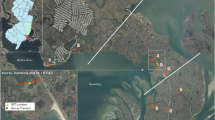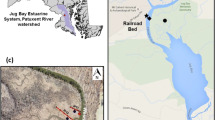Abstract
A fundamental question in ecology is how biological interactions and biogeographic processes interact to determine the biodiversity of local sites. We quantified patterns of plant species diversity on transects across elevation at 59 salt marsh sites in Georgia and 49 sites in Texas. Although these regions have similar climates and floras, we anticipated that diversity might differ because of differences in tidal regime. Diversity was measured at global, regional, site, and plot scales to consider processes occurring at all levels. Species pools were similar between regions. Texas had greater diversity at the site and plot scales, suggesting that processes occurring at the site scale differed. The greater diversity of Texas sites and plots was associated with wider distributions of individual species across the marsh landscape and proportionally more middle marsh (a high diversity zone) and less low marsh (a low diversity zone) than in Georgia marshes. Preliminary data suggested that these differences were not due to differences in salinity regime or standing biomass between regions, leaving differences in tidal regime as the most plausible hypothesis accounting for differences in plant diversity. We speculate that the less-predictable tidal regime in Texas leads to temporal variation in abiotic conditions that limit the ability of any one species to competitively exclude others from particular marsh zones.




Similar content being viewed by others
References
Abrams, P.A. 1995. Monotonic or unimodal diversity productivity gradients-what does competition theory predict? Ecology 76: 2019–2027.
Adams, D.A. 1963. Factors influencing vascular plant zonation in North Carolina salt marshes. Ecology 44: 445–456.
Alexander, H.D., and K.H. Dunton. 2002. Freshwater inundation effects on emergent vegetation of a hypersaline salt marsh. Estuaries 25: 1426–1435.
Bertness, M.D. 1991a. Interspecific interactions among high marsh perennials in a New England salt marsh. Ecology 72: 125–137.
Bertness, M.D. 1991b. Zonation of Spartina patens and Spartina alterniflora in a New England salt marsh. Ecology 72: 138–148.
Bertness, M.D., and A.M. Ellison. 1987. Determinants of pattern in a New England salt marsh plant community. Ecological Monographs 57: 129–147.
Bertness, M.D., and S.W. Shumway. 1993. Competition and facilitation in marsh plants. American Naturalist 142: 718–724.
Bertness, M.D., K. Wikler, and T.O.M. Chatkupt. 1992. Flood tolerance and the distribution of Iva frutescens across New England salt marshes. Oecologia 91: 171–178.
Brewer, J.S., J.M. Levine, and M.D. Bertness. 1997. Effects of biomass removal and elevation on species richness in a New England salt marsh. Oikos 80: 333–341.
Callaway, R.M., and L.R. Walker. 1997. Competition and facilitation: a synthetic approach to interactions in plant communities. Ecology 78: 1958–1965.
Chapman, V.J. 1974. Salt marshes and salt deserts of the world. In Ecology of halophytes, eds. R.J. Reimold, and W.H. Queen, 3–19. New York: Academic.
Costa, C.S.B., J.C. Marangoni, and A.M.G. Azevedo. 2003. Plant zonation in irregularly flooded salt marshes: relative importance of stress tolerance and biological interactions. Journal of Ecology 91: 951–965.
Crain, C.M., B.R. Silliman, S.L. Bertness, and M.D. Bertness. 2004. Physical and biotic drivers of plant distribution across estuarine salinity gradients. Ecology 85: 2539–2549.
Duncan, W.H., and M.B. Duncan. 1987. The Smithsonian guide to seaside plants of the Gulf and Atlantic coasts from Louisiana to Massachusetts, exclusive of lower peninsular Florida. Washington, DC: Smithsonian Institution Press.
Dunton, K.H., B. Hardegree, and T.E. Whitledge. 2001. Response of estuarine marsh vegetation to interannual variations in precipitation. Estuaries 24: 851–861.
Eleuterius, L.N. 1989. Natural selection and genetic adaptation to hypersalinity in Juncus roemerianus Scheele. Aquatic Botany 36: 45–53.
Eleuterius, L.N., and C.K. Eleuterius. 1979. Tide levels and salt marsh zonation. Bulletin of Marine Science 29: 2471–2485.
Ewing, K. 1983. Environmental controls in Pacific Northwest intertidal marsh plant communities. Canadian Journal of Botany 61: 1105–1116.
Forbes, M.G., and K.H. Dunton. 2006. Response of a subtropical estuarine marsh to local climatic change in the southwestern Gulf of Mexico. Estuaries and Coasts 29: 1242–1254.
Ganong, W.F. 1903. The vegetation of the Bay of Fundy salt and diked marshes: an ecological study. Botanical Gazette 36: 161–186, 280–302, 350–367, 429–455.
Gough, L., and J.B. Grace. 1997. The influence of vines on an oligohaline marsh community: results of a removal and fertilization study. Oecologia 112: 403–411.
Gough, L., and J.B. Grace. 1998a. Effects of flooding, salinity and herbivory on coastal plant communities, Louisiana, United States. Oecologia 117: 527–535.
Gough, L., and J.B. Grace. 1998b. Herbivore effects on plant species density at varying productivity levels. Ecology 79: 1586–1594.
Gough, L., and J.B. Grace. 1999. Effects of environmental changes on plant species density: comparing predictions with experiments. Ecology 80: 882–890.
Gough, L., J.B. Grace, and K.L. Taylor. 1994. The relationship between species richness and community biomass: the importance of environmental variables. Oikos 70: 271–279.
Grime, J.P. 1973. Competitive exclusion in herbaceous vegetation. Nature 242: 344–347.
Hacker, S.D., and M.D. Bertness. 1999. Experimental evidence for factors maintaining plant species diversity in a New England salt marsh. Ecology 80: 2064–2073.
Hacker, S.D., and S.D. Gaines. 1997. Some implications of direct positive interactions for community species diversity. Ecology 78: 1990–2003.
Hargrove, W.W., B. Hayden, D. Urban, J. MacMahon, J. Franklin, and F.M. Hoffman. 2006. Development of a domain map for nodes of the National Ecological Observatory Network (NEON). In Proceedings of the 21st Annual Symposium of the International Association for Landscape Ecology, United States Regional Association (US-IALE), San Diego.
Harrison, S., H.D. Safford, J.B. Grace, J.H. Viers, and K.F. Davies. 2006. Regional and local species richness in an insular environment: serpentine plants in California. Ecological Monographs 76: 41–56.
Huston, M.A. 1994. Biological diversity: the coexistence of species on changing landscapes. Cambridge: Cambridge University Press.
Huston, M.A. 1999. Local processes and regional patterns: appropriate scales for understanding variation in the diversity of plants and animals. Oikos 86: 393–401.
Hutchinson, G.E. 1959. Homage to Santa Rosalina, or why are there so many kinds of animals? American Naturalist 93: 145–159.
Jacobson, H.A., and G.L.J. Jacobson. 1989. Variability of vegetation in tidal marshes of Maine, U.S.A. Canadian Journal of Botany 67: 230–238.
MacArthur, R.H. 1972. Geographical ecology: patterns in the distribution of species. New York: Harper and Row.
Mittelbach, G.G., C.F. Steiner, S.M. Scheiner, K.L. Gross, H.L. Reynolds, R.B. Waide, M.R. Willig, S.I. Dodson, and L. Gough. 2001. What is the observed relationship between species richness and productivity? Ecology 82: 2381–2396.
Oksanen, J. 1996. Is the humped relationship between species richness and biomass an artefact due to plot size? Journal of Ecology 84: 293–295.
Pärtel, M., M. Zobel, K. Zobel, and E. van der Maarel. 1996. The species pool and its relation to species richness: evidence from Estonian plant communities. Oikos 75: 111–117.
Pennings, S.C., and M.D. Bertness. 2001. Salt marsh communities. In Marine Community Ecology, eds. M.D. Bertness, S.D. Gaines, and M.E. Hay, 289–316. Sunderland: Sinauer.
Pennings, S.C., and R.M. Callaway. 1992. Salt marsh plant zonation: the relative importance of competition and physical factors. Ecology 73: 681–690.
Pennings, S.C., and D.J. Moore. 2001. Zonation of shrubs in western Atlantic salt marshes. Oecologia 126: 587–594.
Pennings, S.C., M.-B. Grant, and M.D. Bertness. 2005. Plant zonation in low-latitude salt marshes: disentangling the roles of flooding, salinity and competition. Journal of Ecology 93: 159–167.
Pennings, S.C., E.R. Selig, L.T. Houser, and M.D. Bertness. 2003. Geographic variation in positive and negative interactions among salt marsh plants. Ecology 84: 1527–1538.
Ponnamperuma, F.N. 1972. The chemistry of submerged soils. Advances in Agronomy 24: 29–95.
Rajaniemi, T.K., D.E. Goldberg, R. Turkington, and A.R. Dyer. 2006. Quantitative partitioning of regional and local processes shaping regional diversity patterns. Ecology Letters 9: 121–128.
Richards, C.L., S.C. Pennings, and L.A. Donovan. 2005. Habitat range and phenotypic variation in salt marsh plants. Plant Ecology 176: 263–273.
Ricklefs, R.E. 1987. Community diversity: relative roles of local and regional processes. Science 235: 367–371.
Rosenzweig, M.L. 1995. Species diversity in space and time. Cambridge: Cambridge University Press.
Snow, A., and S.W. Vince. 1984. Plant zonation in an Alaskan salt marsh. II. An experimental study of the role of edaphic conditions. Journal of Ecology 72: 669–684.
Stevens, M.H.H., and W.P. Carson. 2002. Resource quantity, not resource heterogeneity, maintains plant diversity. Ecology Letters 5: 420–426.
Stout, J.P. 1984. The ecology of irregularly flooded salt marshes of the northeastern Gulf of Mexico: a community profile. Washington, DC: US Department of the Interior, Fish and Wildlife Service.
Tilman, D. 1982. Resource competition and community structure. Princeton: Princeton University Press.
Turner, R.E. 1976. Geographic variations in salt marsh macrophyte production: a review. Contributions in Marine Science 20: 47–68.
Wang, F.C. 1997. Dynamics of intertidal marshes near shallow estuaries in Louisiana. Wetlands Ecology and Management 5: 131–143.
Wiegert, R.G., and B.J. Freeman. 1990. Tidal salt marshes of the southeast Atlantic coast: a community profile. Washington, DC: US Department of the Interior, Fish and Wildlife Service.
Zetler, B., and D. Hansen. 1970. Tides in the Gulf of Mexico: a review and a proposed program. Bulletin of Marine Science 20: 57–69.
Zobel, M. 1992. Plant species coexistence—the role of historical, evolutionary and ecological factors. Oikos 65: 314–320.
Acknowledgments
We thank the Environmental Institute of Houston for funding, Nadia Deeb for her help with field work and data entry, Wade Sheldon, John Carpenter, Betsy Terrel, and Dawn Kaufman for assistance, and Ricardo Azevedo, Paul Harcombe, Emily Marquardt, and Michael Travisano for helpful comments on the work and manuscript. This is contribution number 969 from the University of Georgia Marine Institute. This work is a contribution of the Georgia Coastal Ecosystems Long-Term Ecological Research program.
Author information
Authors and Affiliations
Corresponding author
Rights and permissions
About this article
Cite this article
Kunza, A.E., Pennings, S.C. Patterns of Plant Diversity in Georgia and Texas Salt Marshes. Estuaries and Coasts 31, 673–681 (2008). https://doi.org/10.1007/s12237-008-9058-3
Received:
Revised:
Accepted:
Published:
Issue Date:
DOI: https://doi.org/10.1007/s12237-008-9058-3




